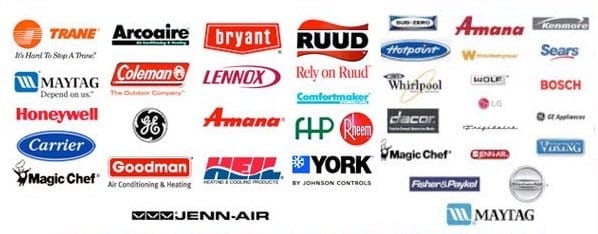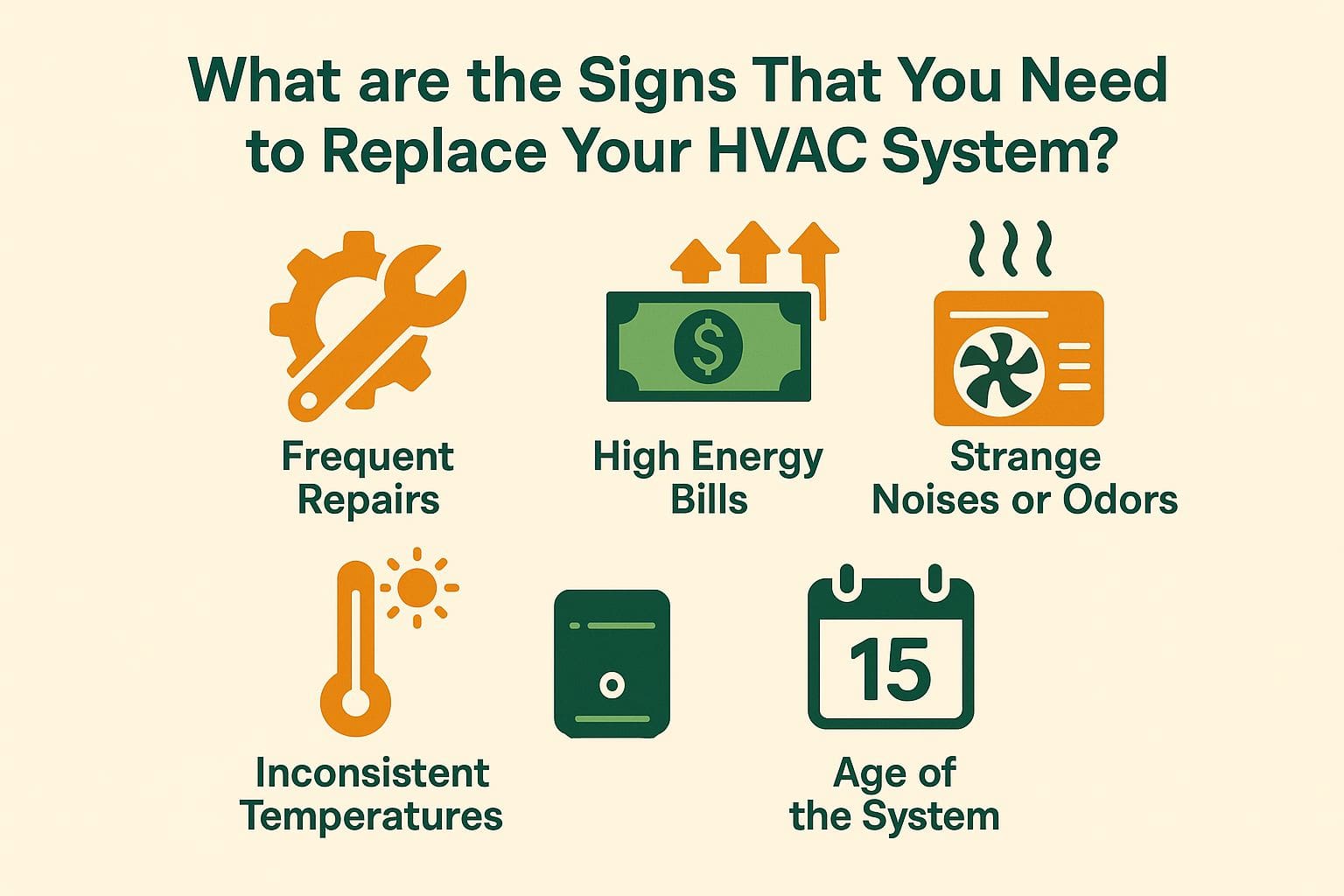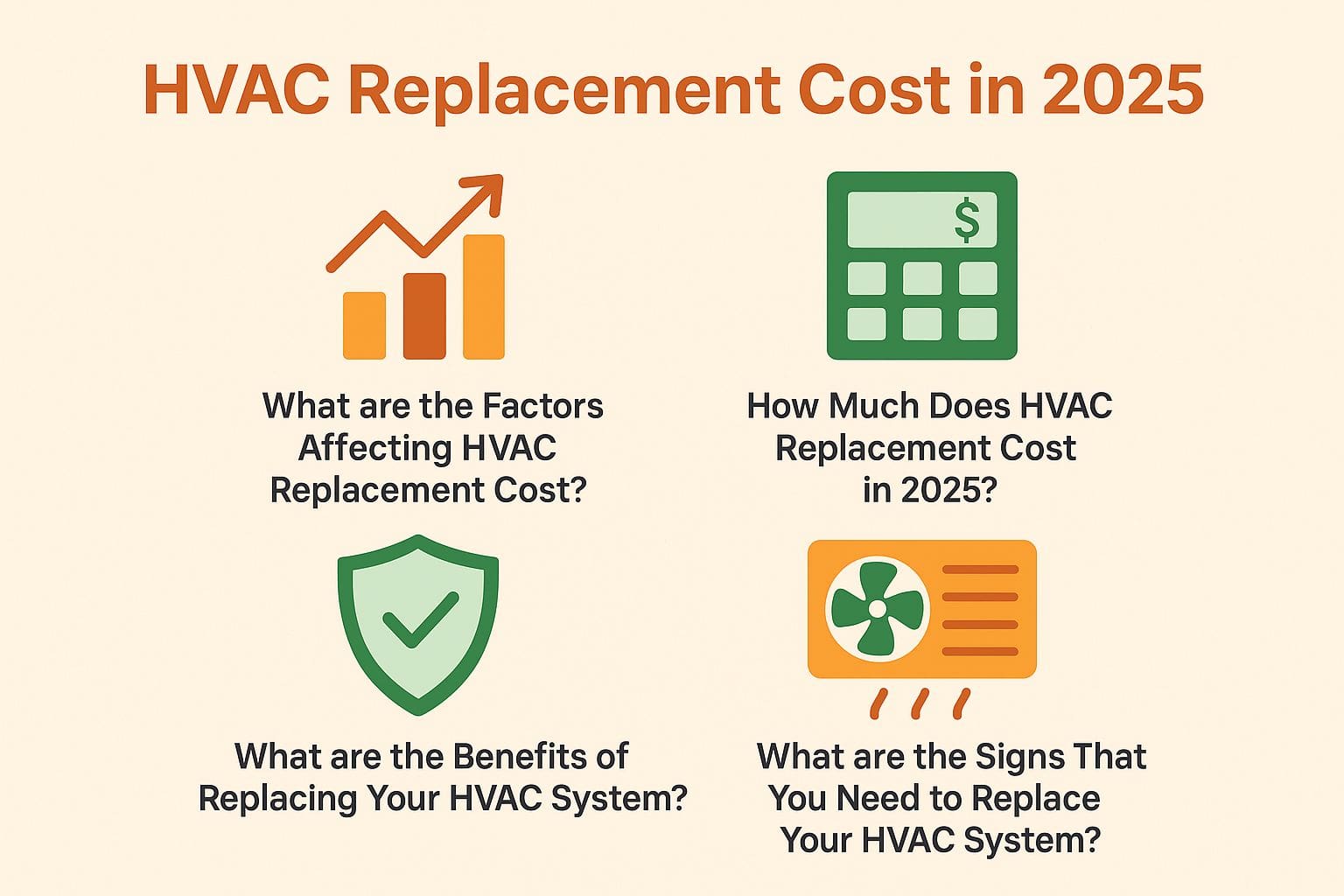 How Much Does HVAC Cost in 2025?
How Much Does HVAC Cost in 2025?
In General, the average cost HVAC replacement in the US ranges between $6,000 – $15,200, while the cost to repair a unit is around $425.
Fill out the form to compare prices and estimates from local HVAC companies.
In terms of replacing your HVAC system, knowing the costs is essential for planning a budget well 💰.
Several factors influence the overall replacement cost, including the type and size of the system, labor costs, and energy efficiency ratings ⚡.
📘 This guide examines these factors, explains the average costs for 2025, and discusses the 🔄 benefits of upgrading your system.
🔍 Learn to identify the signs that indicate it’s time for a replacement, ensuring you make an informed decision for your home.
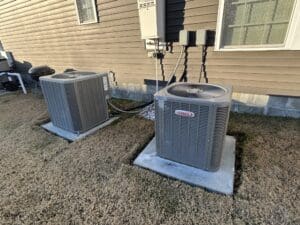
What are the Factors Affecting HVAC Replacement Cost?
When considering the cost to replace an HVAC system, various elements can affect how much you will pay.
The type of HVAC system you select, which includes heating, ventilation, and air conditioning options, is important for determining both the initial expense and long-term energy efficiency of your home or business. New HVAC technology provides ways to save energy and improve home projects.
Other elements like home size, local rules, and how difficult the installation is can affect upfront costs and ongoing operation expenses. Geographic location and specific HVAC installation permits required in certain areas may also influence the replacement cost.
Knowing these aspects will help you make decisions that fit your budget and energy savings plans. Doing energy audits can help you learn more about possible ways to improve energy efficiency. See also: How Much Does HVAC Cost in 2025?
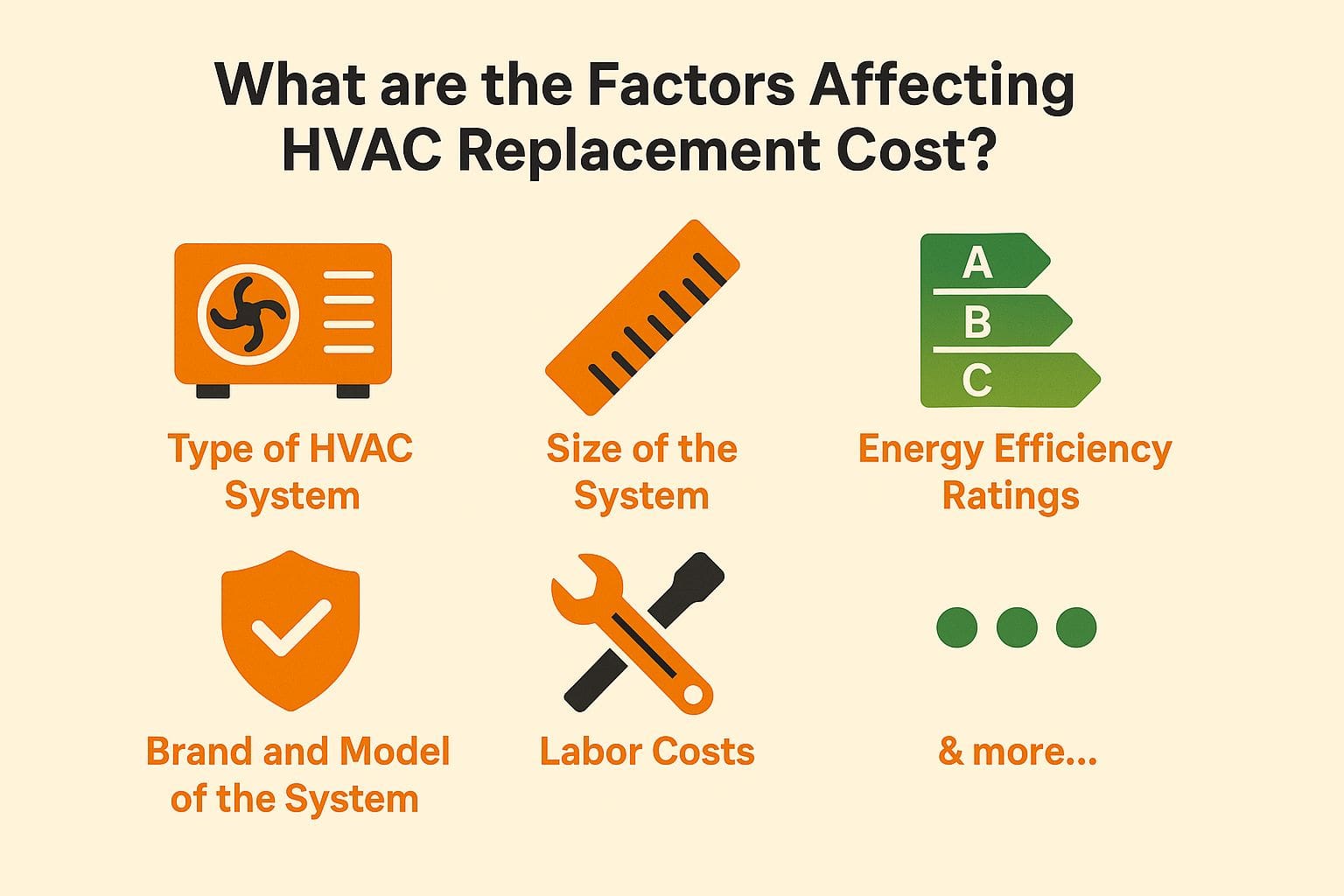
1. Type of HVAC System
The type of HVAC system you choose is one of the most significant factors affecting both the initial purchase price and the long-term energy efficiency of your home or business.
When selecting an HVAC system, it’s essential to consider options such as central air conditioning, which offers widespread cooling benefits, and heat pumps, known for their versatility in both heating and cooling.
The growth of intelligent HVAC choices brings new technology that lets people manage and watch over climate settings more closely, improving comfort.
Brands of equipment are very important for how well they work. Different makers use various refrigerants, like R-410A or R-22, which affect how the equipment impacts the environment and how well it works.
Selecting models that use less energy can lower your energy bills. But think about both the upfront costs and potential savings later to make a wise decision.
2. Size of the System
The size of your HVAC system is critical because it directly impacts its efficiency and effectiveness in heating or cooling your space.
Picking the correct size for an HVAC system is important for comfort and saving money over time. An undersized unit may struggle to maintain the desired temperature, leading to excessive wear and tear, while an oversized system can cycle on and off too frequently, wasting energy and driving up utility bills.
The layout of the ductwork plays a significant role in airflow distribution; if the ducts are inadequately sized or improperly installed, even a perfectly sized HVAC system might fail to deliver optimal performance. Homeowners need to make sure that the equipment and ductwork fit together properly to save energy and lower running costs.
3. Energy Efficiency Ratings
Energy efficiency ratings are important for figuring out the ongoing expenses of your HVAC system and how it affects your energy bills.
These ratings, like Seasonal Energy Efficiency Ratio (SEER) and Energy Efficiency Ratio (EER), show how effectively an air conditioning system uses energy to provide cooling.
A higher SEER rating indicates greater efficiency over an entire cooling season, while EER reflects efficiency for specific operating conditions.
By investing in a highly rated system, homeowners can greatly reduce their energy use and monthly bills. For those looking to upgrade, exploring the best HVAC systems of 2025 can provide insight into the most efficient options available.
This helps create a more sustainable environment and increases comfort, providing a good balance between performance and cost savings.
4. Brand and Model of the System
The type and brand of your HVAC system can affect both how much it costs to replace and how reliable and efficient it is as time goes on.
This means that choosing the right equipment involves more than just how it looks or what it costs at first. It’s important to know how different brands work in different situations and how good their customer support is.
Market trends show that people increasingly prefer energy-efficient models. These models help lower utility bills and support environmental sustainability.
Consumer reviews are important in deciding, as they show what users experience and how happy they are.
Warranty terms can differ a lot between manufacturers, which can impact long-term maintenance expenses and assurance. It’s important to examine these aspects closely.
5. Labor Costs
Labor costs are an often-overlooked component of HVAC replacement, significantly influencing your overall financial commitment. Checking contractor credentials and securing service agreements can help manage these expenses.
These expenses can fluctuate based on various factors, including the intricacy of the installation, which might require specialized skills or additional labor hours. Contractor fees can vary depending on their experience and local market conditions, potentially adding to the budget.
It can be difficult to find qualified technicians during peak periods, leading to increased expenses. To effectively budget for these costs, homeowners should obtain multiple quotes and consider potential hidden expenses, ensuring they understand how labor influences the total bill for HVAC replacement.
6. Additional Components and Features
Extra parts and features in your HVAC system, like zoning systems and advanced technology, can improve its efficiency, but they also increase the replacement costs.
Incorporating a zoning system allows for individualized temperature control in different areas of a home, significantly improving comfort while potentially increasing energy efficiency.
Using advanced technology allows for quick checks and automatic adjustments based on space usage, which can help reduce energy costs over time.
These advanced systems often need more money upfront and might need expert care to work at their best. Regular maintenance checks, like changing filters and adjusting the system, are important for keeping the HVAC system working well and reducing surprise repair costs. This approach helps save money over the system’s lifetime.
7. Location and Accessibility
The position and ease of access to your HVAC system can greatly affect how quickly it can be installed and the total costs. Accessibility issues can be mitigated by consulting with HVAC specialists familiar with the local geographical impact and building codes.
For instance, if the system is situated in a difficult-to-reach area, the labor time and effort required to replace it can increase substantially, leading to higher service fees. It is important to consider the total cost, which includes possible savings from utility discounts and rebates.
Local climate conditions can also influence the type of system best suited for replacement, impacting both equipment prices and energy efficiency over time. Considerations such as harsh winters or hot summers may necessitate more advanced systems, which can drive up costs.
Varying geographical regulations may impose specific installation permits or requirements that could add to the overall expense. Understanding local information is crucial for homeowners looking to make informed decisions about upgrading their HVAC systems.
❄️🔥 HVAC Replacement Cost Factors – Summary
| Factor | Description | 💸 Cost Impact |
|---|---|---|
| 🛠️ Type of HVAC System | Central AC, heat pumps, smart systems; impacts energy efficiency & initial cost. | New tech = more upfront but better long-term savings. |
| 📏 System Size | Must match home size & ductwork; too big or small leads to inefficiency. | Wrong size = wasted energy & higher bills. |
| ⚡ Energy Efficiency Ratings | SEER & EER ratings affect monthly bills and energy usage. | Higher rating = lower monthly costs. |
| 🏷️ Brand & Model | Brand reliability, support, warranties, and user reviews vary. | Premium brands = higher cost but better longevity. |
| 👷 Labor Costs | Varies by complexity, location, contractor skill, and time of year. | Peak season or tough installs = higher labor cost. |
| ⚙️ Additional Features | Zoning systems, smart controls, filtration add comfort & efficiency. | Adds cost but improves control & savings over time. |
| 📍 Location & Accessibility | Hard-to-reach systems or local permit rules can increase cost. | Difficult access = higher service fees. |
How Much Does HVAC Replacement Cost in 2025?
1. Average Cost of HVAC Replacement
The average cost of HVAC replacement can vary widely, but having a clear estimate helps you plan your budget accordingly.
Knowing the costs and expenses linked to HVAC systems is important for homeowners. Factors such as the type of system, the size of the area being serviced, and the complexity of the installation all play significant roles in determining the total expense.
For instance, a central air conditioning system might range from $3,000 to $7,000 for equipment alone, with installation costs potentially adding another $1,000 to $3,000. In contrast, a ductless mini-split system may have equipment prices between $2,000 and $5,000, along with lower installation expenses due to its simpler setup.
Checking these options will help you make decisions that fit your financial needs.
2. Factors that May Affect the Cost in 2025
Various economic conditions and changes in the market will affect HVAC replacement prices in 2025, so it is important to stay updated.
Knowing these factors can help you predict possible changes and manage your financial planning better. For example, inflation might increase the costs of materials and labor, which would raise the final price of an HVAC system.
Continued problems in the supply chain might result in fewer key parts, which could lead to higher prices or postpone installation. It’s important to look at the financing options available since interest rates can change and impact your total costs.
Beginning early in these areas can help people and companies create a clearer budget and manage HVAC costs.
Below is a table showing estimated costs to replace your HVAC unit.
| HVAC Unit Installation – By Type | Low Cost | High Cost |
|---|---|---|
| Central Air Conditioner | $6,594 | $12,115 |
| Ductless Split AC | $2,185 | $4,015 |
| Electric Furnace | $782 | $3,594 |
| Gas Furnace | $975 | $3,948 |
| Oil Furnaces | $3,392 | $8,386 |
| Heat Pump | $2,963 | $7,598 |
| Geothermal Heat Pumps | $15,300 | $38,760 |
What are the Benefits of Replacing Your HVAC System?
Upgrading your HVAC system can improve both comfort in your home and its efficiency, while also increasing its value. A modern system can improve indoor air quality and heating performance, which can increase a home’s energy rating and resale value. For homeowners considering which system to choose, our comparison of the best HVAC systems of 2025 offers insightful guidance on selecting the most efficient options.
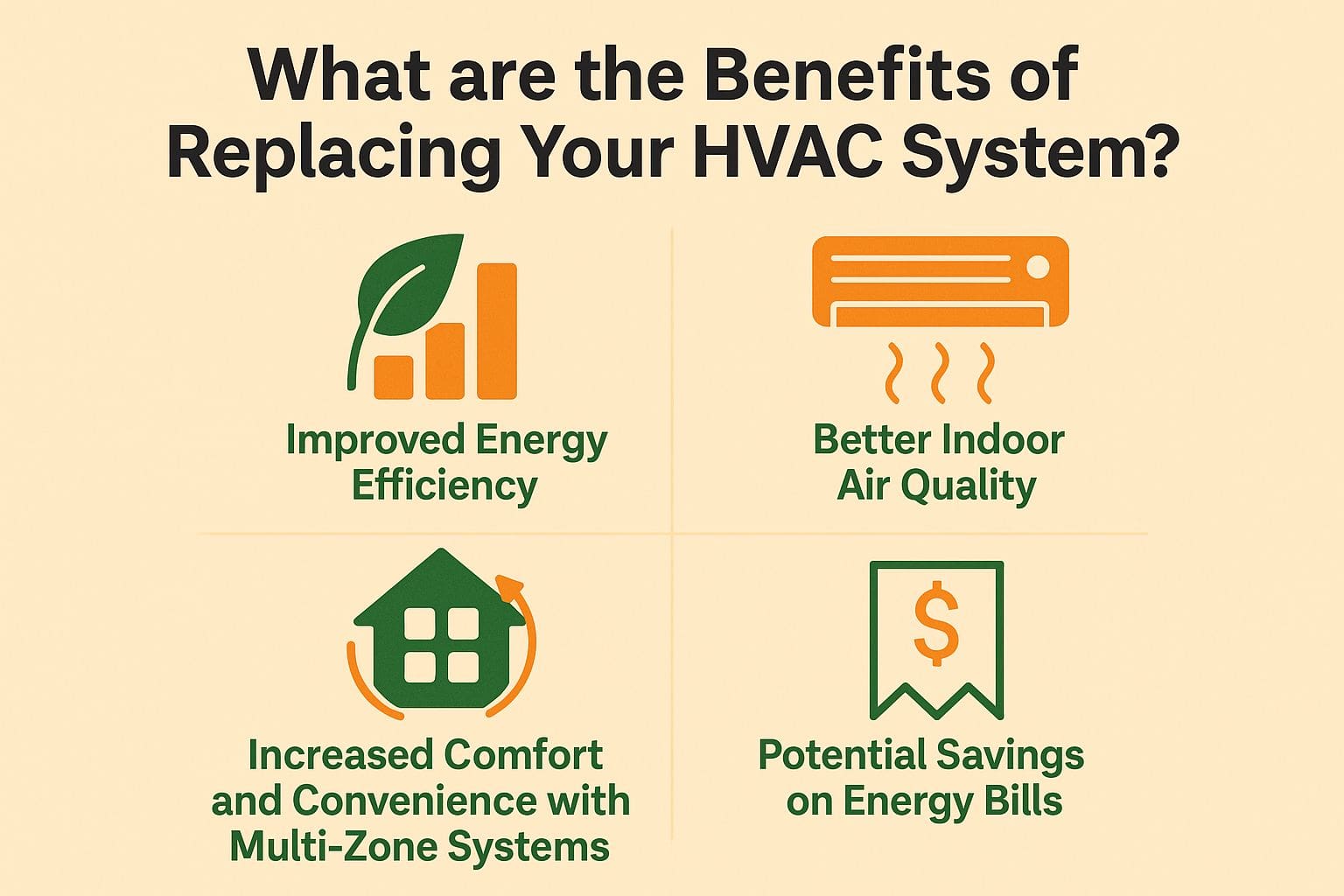
1. Improved Energy Efficiency
One of the most significant advantages of upgrading your HVAC system is the potential for improved energy efficiency, which directly impacts operational costs.
Modern HVAC systems use new technologies, such as variable speed motors and intelligent thermostats, to control temperature precisely and accommodate various needs.
This means homes keep the best temperature settings and energy waste is greatly reduced all year. Using home automation systems and programmable thermostats can increase these advantages.
As consumers make the transition to these more efficient systems, they can expect noticeable reductions in utility bills over time, translating to substantial long-term savings.
By consuming less energy, these upgraded HVAC systems contribute to lower greenhouse gas emissions, promoting a healthier environment and reinforcing the importance of sustainable practices in our daily lives. The ecological impact of these systems is substantial in combating climate change.
2. Better Indoor Air Quality
A new HVAC system can greatly improve your indoor air quality, which is essential for your health and overall well-being, while also enhancing your home’s valuation by increasing its energy performance.
With advancements in technology, these systems now come equipped with high-efficiency particulate air (HEPA) filters that effectively capture airborne pollutants, allergens, and even microscopic particles.
Improved ventilation systems make sure that fresh, clean air moves through the living space, lowering the buildup of indoor pollutants.
Regular maintenance practices, such as changing filters and scheduling professional cleanings, further support this improved air quality.
By performing energy audits, you can find ways to improve and keep systems running well, ensuring good air quality.
This complete method improves comfort and supports a healthier home setting.
3. Increased Comfort and Convenience with Multi-Zone Systems
With modern HVAC technology, such as smart features, installing a new system can make your home more comfortable and easy to manage.
These modern systems often include zoning features, allowing you to set different temperatures for various areas of the house, ensuring comfort for everyone.
Using modern technology can make things better for homeowners by letting them control their heating and cooling systems from their phones. This offers convenience and lets users save energy by changing settings according to how often a space is used and personal likes.
These changes make the home more comfortable and enjoyable, matching what the residents need.
4. Potential Savings on Energy Bills through HVAC Efficiency
One of the most immediate benefits of replacing your HVAC system is the potential for significant savings on your energy bills.
By integrating energy-efficient systems, homeowners can see reductions of up to 30% in their monthly utility expenses.
For instance, a high-efficiency furnace or air conditioner, specifically those with a SEER rating of 16 or more, can lead to average annual savings of approximately $200 to $500, depending on energy rates and usage.
Over time, these savings accumulate, often covering the installation costs within just a few years. Many modern HVAC systems include technology that improves performance by adjusting to how often they are used, which saves more energy.
This reduces running costs and raises the property’s overall value, confirming the worth of the energy-efficient improvements, with a positive return on investment (ROI).
What are the Signs That You Need to Replace Your HVAC System?
Noticing when your HVAC system needs to be changed can help you avoid surprise costs and inconvenience later. To better prepare for potential expenses, understanding how much an HVAC system might cost in 2025 can be crucial.
1. Frequent Repairs
If you often need to fix your HVAC system, it might be time to think about getting a new one, considering the replacement timeline and potential fuel type adjustments.
Repeatedly investing in repairs can often point to deeper, more significant issues within the system, suggesting that it could be nearing the end of its service life.
For instance, if an HVAC unit requires new compressors or evaporators frequently, the overall expenses can rise quickly.
In some cases, the cost of continuous patchwork on an aging system can surpass the price of a new, energy-efficient model.
When fixing things one after another, what first appears to be a small repair can lead to more problems, eventually increasing costs over time.
2. High Energy Bills
High energy bills might mean your HVAC system isn’t working well and could need replacing.
As systems age, they often lose their original efficiency, causing them to work harder to maintain the desired temperature. This can cause increased energy bills and uneven heating or cooling in the home.
Upgrading to a modern, energy-efficient unit can make a significant difference, providing cost savings over time while enhancing overall comfort. Using energy wisely means reducing energy use while still achieving the same outcomes. This approach helps cut costs and benefits the environment when controlling indoor temperatures.
3. Inconsistent Temperatures
Inconsistent temperatures throughout your home can indicate that your HVAC system is struggling to maintain a comfortable environment.
Various factors, such as zoning issues or failing components, can exacerbate these temperature differences. For instance, if specific zones within a house are not properly insulated or the ductwork is poorly designed, air distribution becomes uneven, leading to some areas feeling chilly while others remain uncomfortably warm.
When components of the HVAC system, like thermostats or dampers, malfunction, they can prevent the system from achieving its desired temperature. These differences can greatly affect comfort levels, often requiring you to think about updates or changes to keep the indoor environment comfortable and enjoyable.
4. Strange Noises or Odors
If your HVAC system begins to make unusual sounds or smells, these might indicate mechanical problems that could require replacing the system.
From squealing or grinding sounds to the smell of burnt wires or musty odors, any unusual noise or scent should not be ignored. Squealing may indicate a slipping belt, while grinding could point to worn-out bearings.
On the other hand, an acrid smell might suggest electrical problems or overheating components, and a musty odor could be a sign of mold growth within the system.
Unwanted sounds and smells can harm how well the HVAC system works, causing it to use more energy, increasing costs, and possibly needing a replacement if routine upkeep doesn’t solve the problems.
5. Age of the System
How old your HVAC system is plays an important role in deciding if you need to replace it.
Typically, systems like central air conditioners and heat pumps last about 10 to 15 years, while furnaces can endure up to 20 years with proper care, thus managing the system’s lifespan effectively.
As these units age, their efficiency tends to diminish, leading to increased energy consumption and higher utility bills. An older system might struggle to maintain a comfortable indoor climate and could be more prone to unexpected breakdowns, which raises concerns about reliability.
Regular upkeep, such as changing filters and having yearly check-ups, is important to make them last longer and work better. Ignoring these important tasks could speed up damage and eventually cause early breakdown.

About the Author
Mark Ellington is a home improvement expert and CEO of a $50M remodeling firm. With 20+ years of experience and a degree in Construction Management from Purdue, he shares practical renovation tips, pricing insights, and contractor advice at 5Estimates.com to help homeowners make smart, informed decisions on their projects.

